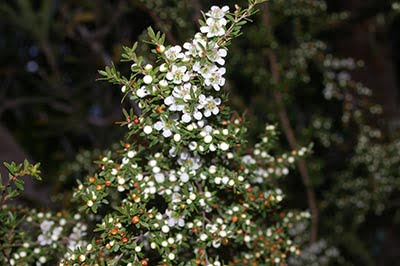Not all Leptospermums are Equal
Medical honey is honey collected from bees foraging on a special species of plants called Leptospermums. But not all Leptospermums are equal. Peter Brooks explains this in detail:
Not all leptospermums are equal – Peter Brooks (Source)
Not all Leptospermums are Equal.
New Zealand Mānuka (Leptospermum scoparium) honeys regularly return $50/kg to the beekeeper. This reflects marketplace recognition for the wound healing and anti-bacterial activity of this honey. All honeys have an antibacterial action through; high sugar/hygroscopic nature, low pH and mild acidity, and hydrogen peroxide generation upon dilution. Mānuka honeys have an additional nonperoxide action through the presence of the dicarbonyl compound – methylglyoxal (MGO). MGO is not present in the nectar of the mānuka flower. Instead, the three carbon sugar, dihydroxyacetone, (DHA) which is present in the mānuka nectar, converts to MGO in the honey as it matures.
Australia has 83 species of Leptospermum, including L. scoparium. A collaboration involving the University of Technology, Sydney, (UTS), University of Sydney (USyd) and University of the Sunshine Coast (USC), which is supported by Rural Industries Research & Development Corporation (RIRDC), Capilano Honey Limited and Comvita Limited, are jointly investigating new sources of active Australian Leptospermum honeys. Carter et al. (2010) first showed Australian honey had antibacterial activity, and that Leptospermum honeys had non-peroxide activity (NPA). Researchers at USC Honey Laboratory (Windsor etal. 2012) later showed DHA and MGO were present in Australian Leptospermum honeys. The current research aims to identify new regions and species for Leptospermum honey within Australia, and to also increase returns to producers through further research into the wound healing properties of these honeys. Individual beekeepers are invited to become involved in the research by donating representative honey samples, and to receive back their test results.
The USC Honey Laboratory has analysed DHA and MGO in thousands of honeys samples. Some are highly active, with greater than 4000ppm DHA and 1000ppm MGO. Many were inactive with little or no DHA and MGO. There appears some confusion within the beekeeping community as to what is Leptospermum, and what is Teatree or Heath. Also many honeys that appeared the classical Leptospermum “jelly like’’ consistency returned no activity. This led us to speculate that not all Leptospermum species are equal. The collaboration has shown that in Australian Leptospermum honeys, the antibacterial activity is a function of the MGO content. This MGO develops in the honey over time from the nectar DHA. At the USC laboratory, we have analysed the nectar from several Australian Leptospermum species, and found they are not all equal. Thus far in this work, L. whitei, L. polygalifolium, L. scoparium and L. liversidgei are active, but L. leavigatum and L. trinervium contain no DHA. Should the nectar of a single tree be converted into fresh honey, the typical DHA ranges present are:

The importance of this information to beekeepers is; targeting the right species for active premium honeys is important. Bees collect from available flowers within a 3 km radius. Single floral sources are impossible with overlapping flowerings, and multiple species present. However the most active species can be targeted, or for lower activity culinary honeys, mixed species are still fine.
The conversion of DHA to MGO as the honey matures is complex. The reaction is dependent on acidity, amino acid content, temperature and time. Some producers mistakenly heat treat honeys to accelerate the process. This is detrimental to the honey’s value. Firstly, at lower temperatures the conversion is slower, but at a higher percentage conversion. At elevated temperatures, DHA is lost faster, but less ends up as MGO. Anecdotally, the conversion is two DHA to one MGO at 20 oC, but three DHA to one MGO at 30 oC. Further elevated temperatures produce the undesired hydroxymethylfurfural (HMF). A maximum level of 40ppm HMF has been set by the International Honey Commission for culinary honeys. Short heat treatments to blend, separate waxes or to decrystallise are fine. Extended heat treatment not only produces HMF, but also does not allow maximum MGO development. In the USC laboratory, storing Leptospermum honeys at 37 oC for 60 days produced on average an 88ppm HMF increase (Windsor etal. 2013). Tasmania has the other problem, where ambient temperatures are often too slow for commercial conversion. We recommend 20-25 oC for 6 months – 2 years for development of MGO.
Dr Peter Brooks
Senior Lecturer in Chemistry
University of the Sunshine Coast
References.
Carter DA, Blair SE, Irish J. An Investigation into the Therapeutic Properties of Honey. RIRDC, 2010
Windsor S, Pappalardo M, Brooks P, Williams S, Manley-Harris M. A convenient new analysis of dihydroxyacetone and methylglyoxal applied to Australian Leptospermum honeys. Journal of Pharmacognosy and Phytotherapy. 2012, 4 6-11
Windsor S, Kavazos K, Brooks P. The quantitation of hydroxymethylfurfural in Australian Leptospermum honeys. Journal of Pharmacognosy and Phytotherapy. 2013, 5, 21-25

